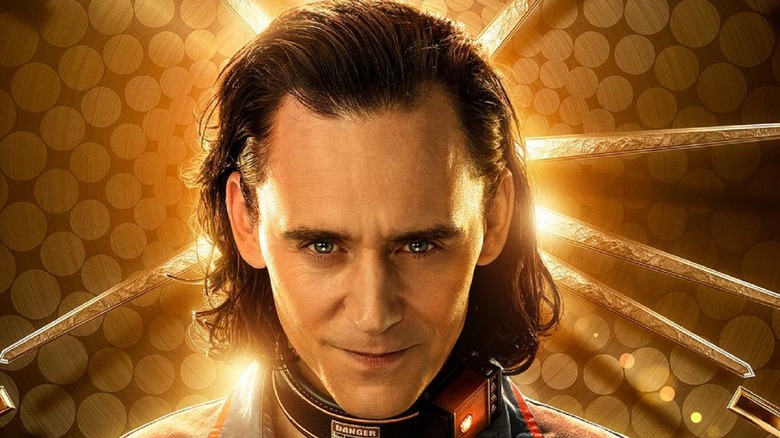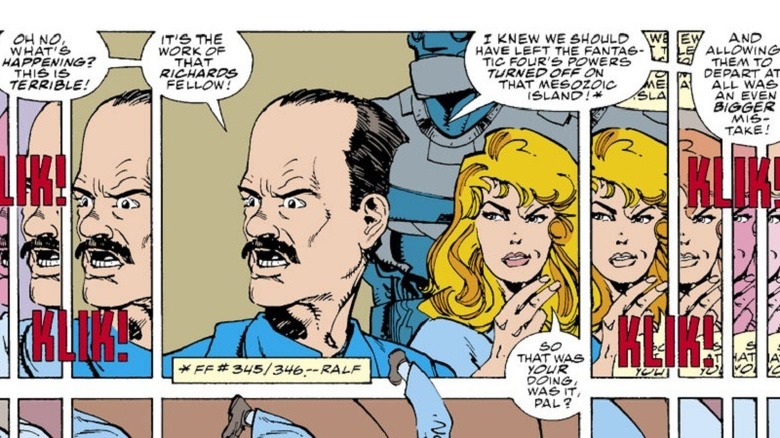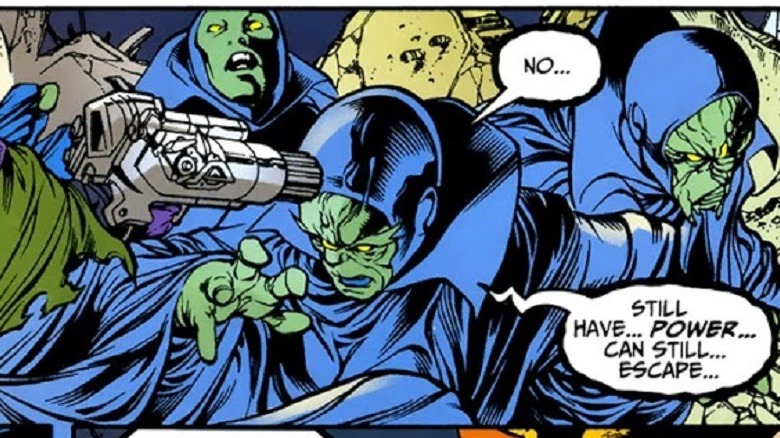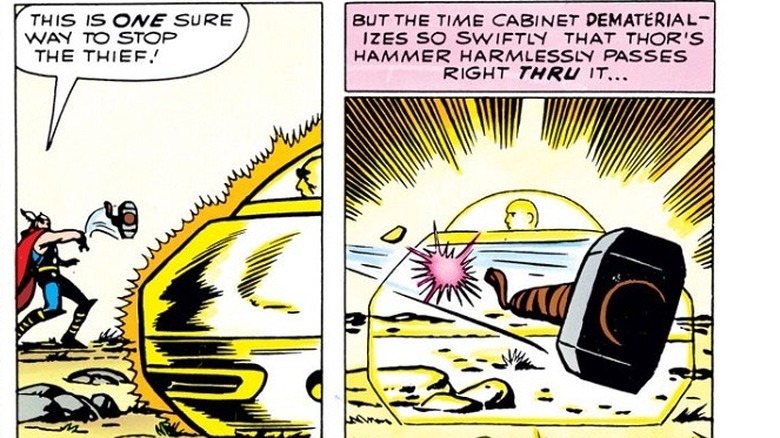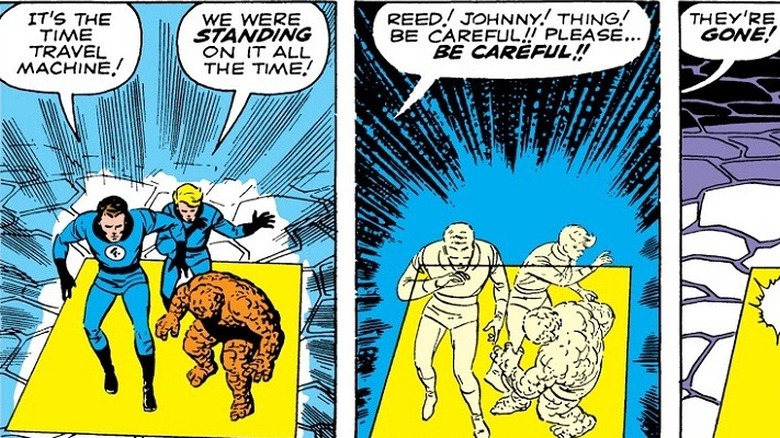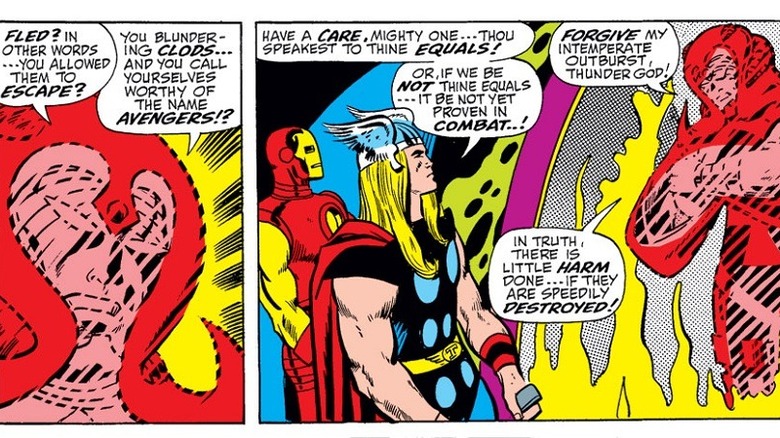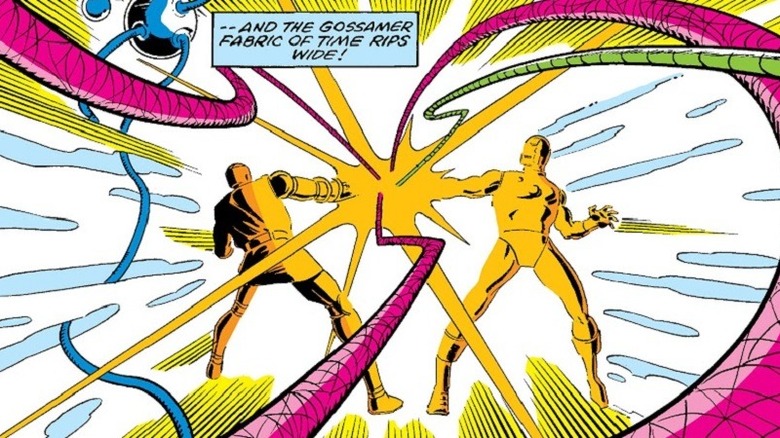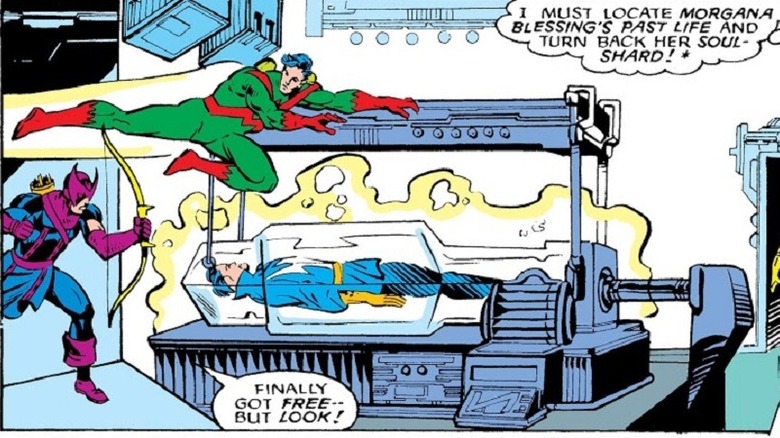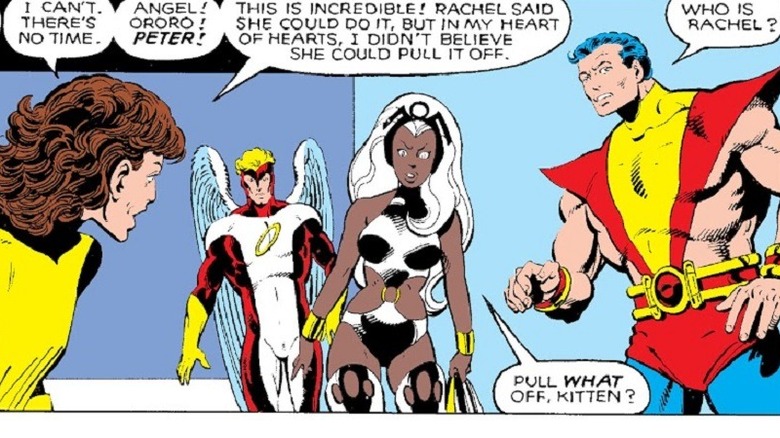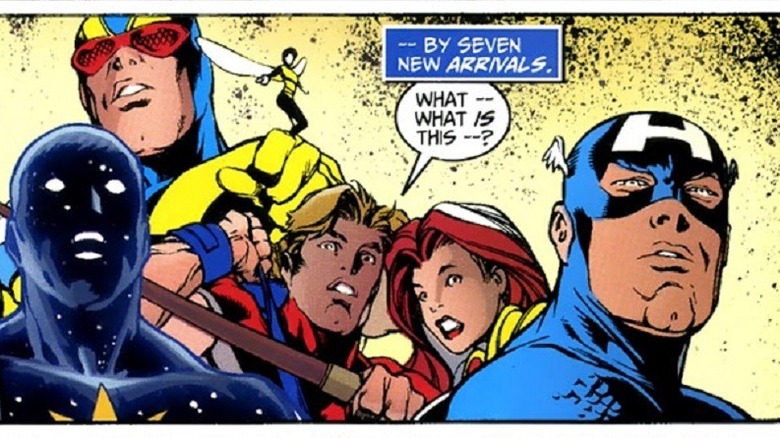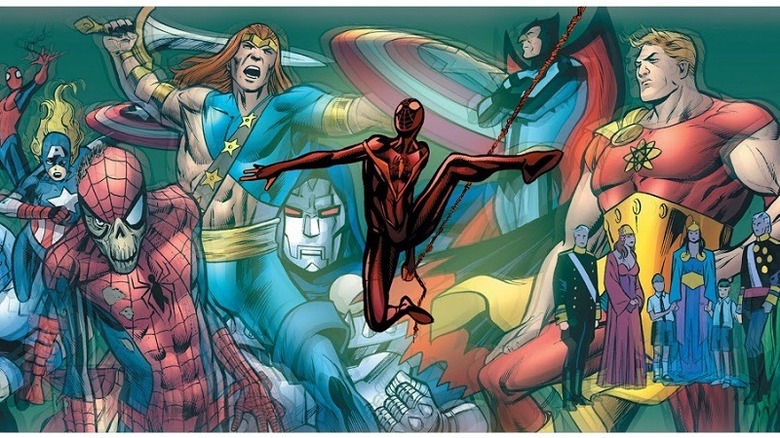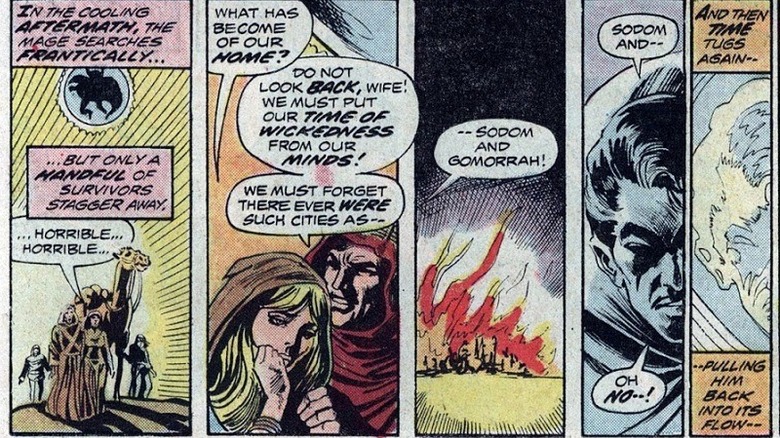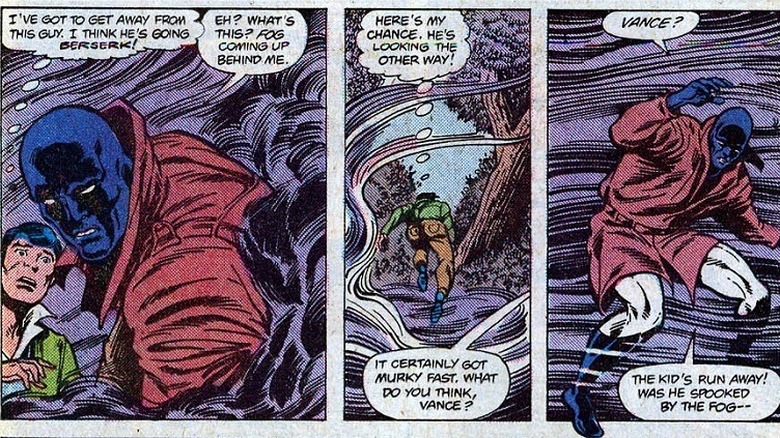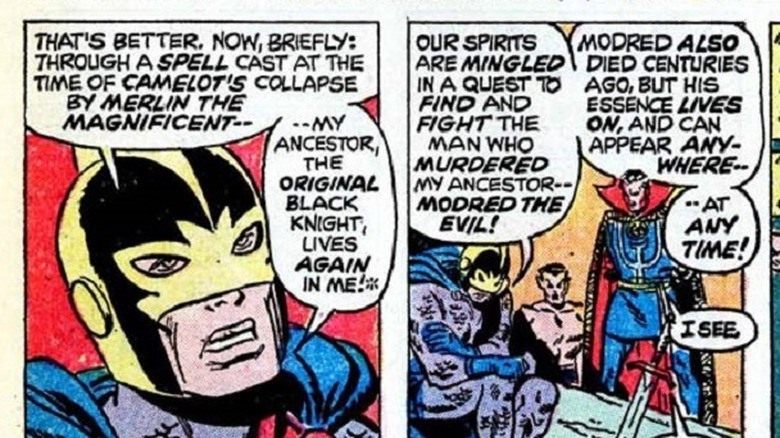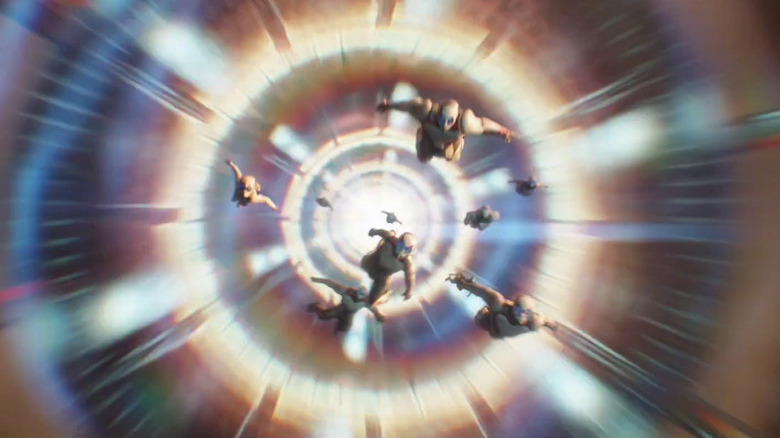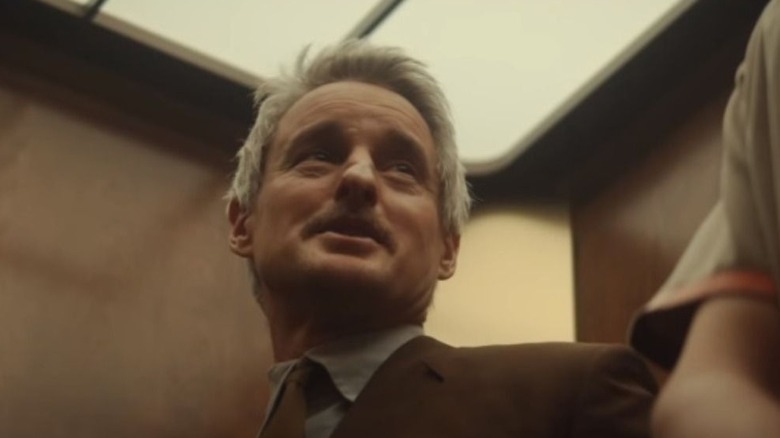The Untold Truth Of Time Travel In Marvel
Ever since Doctor Doom forced the Fantastic Four to go back in time in order to retrieve Blackbeard's treasure in "Fantastic Four" #5 (1962), time travel has been an increasingly convoluted story trope in the Marvel Universe. There have been time-traveling villains like Kang the Conqueror and Zarrko the Tomorrow Man who keep returning to the past in order to rule it, but heroes have engaged in their own shenanigans: Doctor Strange's use of time travel through magic, for example, set the precedent for him getting the Time Stone as part of the Eye of Agamotto in the MCU. Time travel stories have gotten stacked on top of other time travel stories. People have come back to the present to prevent apocalyptic futures, but that trick never works.
Stories that try to explain how time travel works in the Marvel Universe tend to only make things more complicated, especially when they're repeatedly retconned. Characters like Immortus, the Time Keepers, and the Time Variance Authority have tried to establish some rules, with generally mixed results. Of course, time travel can get pretty confusing even under the best of circumstances, but the details are even hazier in the Marvel Universe, where there are no time paradoxes — instead, whenever someone attempts to go back or forward in time, they pop into Limbo and create a divergent reality. These alternate realities make up the multiverse and make everything extra confusing. With all that in mind, let's unravel a few of the more interesting stories regarding time travel in the Marvel Universe.
The Time Variance Authority: bureaucracy in inaction
The Time Variance Authority was introduced in "Thor" #371 as a time agency that sent freelance operative Justice Peace to stop an immortal killer named Zaniac. The members of the Authority were later revealed to be a group of cloned bureaucrats living in the Null-Time Zone, filling out forms in triplicate and making sure no one broke any temporal rules. One middle manger, the wonderfully named Mobius T. Mobius, arrested the Fantastic Four for time infractions, but Reed Richards escaped and took the file on his reality with him as he scampered off.
When one of his supervisors realized that the file was missing, Mobius tried to find Richards; failing, he kidnapped the rest of the Fantastic Four, including their new recruit Ant-Man. The whole mess was resolved when the FF convinced Mobius to look for another job, he went for a job interview with Kang the Conqueror, and an offer was made. The TVA then counter-offered, making Mobius a happy man and keeping the FF's reality safe.
Speaking of reality, a desperate TVA once employed the Watcher to fix the problem of Immortus manipulating the nexus beings of various realities so he could become the undisputed master of time. The Watcher suggested altering Immortus so he would be incapable of harnessing as much energy as he did, and disaster was averted. The TVA took credit for everything, of course.
The Time Keepers are in it for themselves
Much like Schrödinger's cat, the Time Keepers existed in a constant state where they were either the time-pruning Time Keepers or else the reality-devouring Time Twisters. In either case, they weren't very nice. They were meant to be a gift of a future universe by He Who Remains, the final director of the Time Variance Authority. Instead, the Time Twisters devoured entire realities, killing trillions in each timeline. Understandably annoyed by all this, Thor convinced He Who Remains to undo their creation, but instead he simply changed their genetic makeup, turning them into the Time Keepers instead.
The Time Twisters managed to reemerge, manipulating Immortus into collecting nexus energy for their own purposes. When this plot was foiled by the Watcher, the Time Keepers made sure the Time Twisters wouldn't emerge again.
However, the Time Keepers' mission was to make sure that humanity didn't become a harmful force. They saw the Avengers as the key to achieving this goal, and tried to make them get rid of their servant the Space Phantom and deal with the Scarlet Witch before she became too powerful. They used Immortus as their servant too, but he often helped the Avengers.
Eventually, the Destiny War between Kang and Immortus revealed the Time Keepers were less interested in preserving the multiverse than they were in preserving their own survival. At the end of time, Kang finally managed to kill them, assuring his own freedom as well as Immortus'.
The time pest: Zarrko the Tomorrow Man
Dr. Artur Zarrko, otherwise known as the Tomorrow Man, is a scientist from the 23rd century. Like many mad scientists from peaceful eras, he was bored and wanted to collect weapons from the past for conquest, so naturally he came to the 20th century and stole a nuclear weapon — making himself one of Thor's first villains. Zarrko was never quite as ambitious or competent as Kang the Conqueror. He wasn't much of a hand-to-hand fighter either, preferring to use his robot friends, like the Servitor, to carry out his bidding.
When Zarrko stole the weapon, Odin helped out his son by giving Mjolnir time-traveling abilities, as if Thor wasn't tough enough already. Thor went to the 23rd century and got the weapon back, giving Zarrko amnesia in the process. Loki, in turn, helped out Zarrko and brought him back to fight Thor, but Thor beat him again, even with many of his powers taken away.
When Zarrko and Kang were competing over the 20th century, Kang manipulated the Avengers, Spider-Man, and the Inhumans into defeating Zarrko for him, leaving behind an empty suit.
In yet another story that never happened, Lord Thor of a potential future who ruled Earth with an iron fist realized his error. Zarrko helped him figure out where it all went wrong and they corrected the error. Of course, this type of story is a good example of a frequent contradiction in Marvel: did Lord Thor's reality became a divergent one, or did it disappear altogether?
The granddaddy of time travel: Dr. Doom's time platform
You have to hand it to Victor Von Doom: he unleashed a crazy time-travel scheme on the Fantastic Four in his very first appearance, inventing a platform that made them disappear into a past era to steal Blackbeard's treasure chest. In a wacky series of events, Ben Grimm actually became Blackbeard and Reed Richards cheated Doom by bringing the chest back, but not its treasure.
This was the first of many times the platform became a crucial component of a Marvel Comics story. For example, the Fantastic Four used it again and met another time-traveler, Rama-Tut, in ancient Egypt. They wouldn't be the last ones to visit that era, either: Captain America asked the Avengers to accompany him back to the past to make sure his best friend and fellow soldier Bucky Barnes really died during World War II; as you may have already guessed, all sorts of weird things happened, like the Avengers materializing when they were supposed to be phantom observers. Immortus was involved, of course.
Years later, Cable and SHIELD's George Washington Bridge argued over the time platform after Doom disappeared and they wound up in World War II-era Latveria. Cable destroyed it, but death is always temporary in the comics, even for time platforms, and it was eventually rebuilt. Many centuries later, Kang found it.
The many faces of Kang the Conqueror
You can't talk about time travel in the Marvel Universe without talking about Nathaniel Richards, who's had a number of time-spanning identities. The descendant (or something — probably) of Reed Richards' father, who had the same name, he was born in the 30th century. Intervention from his future self, aka Kang, influenced Nathaniel into becoming Iron Lad and forming the Young Avengers. He fell in love with Cassie Lang, daughter of Ant-Man, but eventually realized he had to go back to his era. Still a teen, he became Kid Immortus after Cassie died, trying to merge with Doctor Doom and Annihilus to destroy the Fantastic Four.
Richards discovered Doom's time platform, using it to become Rama-Tut and conquer ancient Egypt. After the Fantastic Four defeated him, he fled and encountered Doom. This encounter influenced this potential descendant of Doom (it's complicated) to adopt a new, armored persona: the Scarlet Centurion. The Centurion altered time such that he controlled the original Avengers, but a newer lineup defeated him and sent him to the 41st century.
That's where he'd become Kang the Conqueror, mastering that world before turning his attention to other planets and timelines. Eventually, Kang got bored with conquest. He went back to Egypt for a while as an older Rama-Tut, then decided to become Immortus, master of time in Limbo. Confused? Don't worry — even Nathaniel probably has a hard time keeping track of it all.
Tony and Vic's excellent Arthurian adventures
When an unscrupulous Stark Industries employee sold electronics components to Doctor Doom, a furious Tony Stark intervened and called off the sale. That led to Doom stealing the components anyway — and Iron Man confronting him. However, in a plot twist, a disgruntled underling of Doom's sent both of them back into the past using the good ol' time platform – and promptly wrecked it.
Where did they go? Camelot. Doom was trying to get there in order to get mystical training from Morgana Le Fey, the powerful sorceress and enemy of King Arthur. Iron Man allied himself with Arthur. Doom headed up Le Fey's army of the dead, but when Iron Man realized that Le Fey was responsible for this invincible army, he confronted her directly, and Doom and Iron Man had to work together in order to construct a crude time machine. They left with a grudging respect for each other's genius.
Years later, Stark and Doom both received half of a mystical artifact. When Doom stole Stark's half, he realized too late that it was waiting for both of them to be together. It was a time machine, powered by magic. Where did they go? Camelot – this time in the far-flung year of 2093. With Arthur reincarnated as a pre-teen, Doom and Iron Man were forced to team up against Stark's descendant Andros and a 100-year-old Doom. When they returned to the present, they forgot everything.
The gloriously convoluted Lost In Space-Time
The various versions of Doom's time platform really get around. The villain Dominus lured the West Coast Avengers into a trap: Stranded in 1876, they helped the Marvel western heroes fight a bunch of their villains. Wonder Man reasoned that if they could find a way to ancient Egypt, they could use Rama-Tut's time machine to get back to the future. They stopped in 1776 to test it and nearly ran into Doctor Strange. While they were there, they ran into an ancestor of their teammate Firebird, and Hawkeye left a note in the family Bible, hoping it would be seen in the future.
When they finally got to Egypt, they were nearly killed by Rama-Tut but were saved by the Egyptian moon god Khonshu. In return for his help, they would fight Rama Tut. The Avengers almost ran into a different time-traveling version of Strange as well as the Fantastic Four while trying to get to Rama Tut's time machine, but they missed out on every opportunity to get back. They managed to secretly save both Strange and the FF so they could return to the present.
In the present, Khonshu sent his subject, Moon Knight, to tell the West Coast Avengers to look at Firebird's note. While it seemed incredible, they grabbed and repaired Dominus' time machine, went back in time, and rescued their teammates. Whew!
Days of Future Past kicks off a lot of confusion
The "Days Of Future Past" storyline that began in "Uncanny X-Men" #141 inspired a movie and multiple sequels in the comics. It essentially opened the Pandora's box of convoluted mutant time travel drama. In the then-future of 2013, an adult Kitty Pryde has her mind projected back into her 13-year-old self. She tells the X-Men that in the future, the world is a hellish place ruled by the Sentinels, who are hunting mutants. She traveled back to prevent the assassination of Senator Robert Kelly and Professor X and avert that future, and it worked — although the future X-Men were also on a last-ditch mission that utterly failed as they died.
The story continued when one of the mutants from the future, a psychic red-headed girl named Rachel, came back to the past and was revealed to be the daughter of Cyclops and Jean Grey. She helped defeat a time-traveling villain named Ahab in the "Days Of Future Present" story. In an issue of Excalibur titled "Days Of Future Tense," the deaths of the original team from 2013 are detailed: On a mission to track down their missing member Douglock, they discovered to their horror that he had been captured by the government and turned into a living computer who killed them all.
Avengers and X-Men Forever and ever
The idea of using villains plucked from different eras is one that's resurfaced in Marvel, starting with Kang's Legion of the Unliving. He plucked Baron Heinrich Zemo, Wonder Man, Midnight, and others right before their deaths and made them serve him. So why not a team of heroes from a variety of timelines? In the "Avengers Forever" miniseries, Kang was trying to resist his seemingly-inevitable transformation into Immortus. His allies were Avengers from across time: the modern-day Goliath and Wasp, Songbird and Captain Marvel from the future, a delusional Yellowjacket, a dejected Captain America from the Watergate era, and Hawkeye from when he was more of a loose cannon. That group was just unpredictable enough to thwart Immortus' plans.
The only team that's encountered time travel more than the Avengers was the X-Men. In "X-Men Forever," a being named Prosh with time-travel capabilities collected Jean Grey, Iceman, the Toad, Mystique, and the Juggernaut and sent them to alter key events in mutant history, ranging from the assassination of Graydon Creed to Toad's own mental breakdown. All of this knowledge helped them defeat the Stranger, a being who'd been manipulating the mutants for years.
Age of Ultron: everything gets worse
The idea of the Time Variance Authority might be silly ... but they have a point. Changing the timeline too many times and creating divergent realities can tear apart a fragile chronal ecosystem. Case in point: Age of Ultron. After messing around in outer space, Ultron disguised himself as a Spaceknight and made his way back to Earth, where a group of villains accidentally activated him.
Ultron attacked Earth from the future, using the Vision as his conduit point. He overwhelmed the planet with Ultron Sentinels, killing most of the world's superheroes. The world's remaining heroes tracked down Nick Fury, who had Doom's time platform, in order to attack Ultron in the future. Meanwhile, Wolverine had another idea: kill Hank Pym, the creator of Ultron, before he could make him.
Logan and Sue Storm went back to the past and Wolverine killed Pym — but when they returned to the future, they found they'd created an alternate future where the world teetered on the edge of its own apocalypse thanks to Morgan Le Fey. Wolverine went back again, to prevent himself from killing Pym, and gave him the idea of creating a backdoor virus in Ultron. It worked, and Ultron was destroyed — but it also broke the timeline, bringing characters like Angela and Miles Morales to the main Marvel Universe.
Doctor Strange has always been a time traveler
When Doctor Strange became Sorcerer Supreme, he took a number of jaunts down time travel lane. The first came when he and Baron Mordo were chasing the 40th sorcerer, Sise-Neg, through time. At each stop, Strange saw Sise-Neg do something important, like destroying the Biblical cities of Sodom and Gomorrah or banishing the monstrous Shuma-Gorath to another dimension (at Strange's behest). Strange himself saved Sir Lancelot, ensuring his survival in Camelot. When Sise-Neg reached the dawn of time, he realized that his role was to make things happen exactly as they had, and Strange got to watch the universe's birth.
Later, Strange and Clea visited Sir Francis Bacon in 1618 and Benjamin Franklin in 1776. While Strange was off hunting a sorcerer named Stygyro, ol' wily Ben seduced Clea — although in the next issue, a new writer revealed that Stygyro was pretending to be Ben Franklin.
Years later, Mordo and Strange renewed their hostilities when he brought Strange to 1943. Teaming with Nick Fury, Strange foiled a ceremony to bring Dormammu to Earth with a love spell, sending Mordo adrift in time.
Vance Astro: man out of time
What's the easiest but most tedious way to travel to the future? Cryogenically freezing your body, of course. This is what Major Vance Astro did, as this astronaut went on a thousand-year journey to a planet orbiting Alpha Centauri in cold storage. In a cruel trick, faster-than-light travel had already been invented centuries before his arrival, so people were waiting for him when he arrived. But it wasn't all bad: Vance was now a man out of time, but he found that latent mutant telekinetic powers had emerged during his voyage.
Good thing too, because he learned that the alien Badoon had conquered Earth. Teaming with the last survivors of Earth's colonies, he joined the Guardians of the Galaxy. Because there always seemed to be a duplicate of Doc Doom's time platform laying around, the Earth resistance brought Captain America and the Thing to the future by accident. Cap inspired a rebellion and the Guardians joined in, with Vance taking special pleasure in meeting Cap.
Later, the Guardians traveled to the 20th century to fight the cosmic menace of Korvac. Vance didn't dare travel to Earth, for fear of meeting his younger self and causing some sort of time anomaly, but he couldn't resist trying to talk his teenage self out of becoming an astronaut and accidentally unleashed young Vance's powers. This created a divergent reality where young Vance grew up to be Justice, while older Vance returned happily to the 30th century.
The Black Knights: men out of time
If you don't have a time machine handy, magic can move your soul through time in order to take over another body. Case in point: the various incarnations of the Black Knight. The original, Sir Percy of Scandia, pretended to be a cowardly dandy to disguise his secret identity as the Black Knight, one of King Arthur's most loyal men. Sir Percy found his spirit thrust forward in time a few times. That included possessing his heroic descendant Dane Whitman's body and meeting the super-hero team Excalibur, as well as being forced into another body by his enemy Morgan Le Fey, which landed him in an insane asylum.
Dane Whitman's career as the new Black Knight was cut short when the Enchantress turned him to stone and magically transported his soul back in time to the Crusades, where he inhabited the body of his 12th century ancestor, Eobar Garrington, and decided to stay there. He eventually became the guardian of the mystic realm of Avalon, and brought the Avengers back to the 12th century to help fight the Fomor, an evil group of gods. Dane was seemingly killed sealing off the Fomor forever, but it was only his host body that was destroyed. His time-traveling spirit returned to the 20th century and his original body was restored. It wasn't his last time travel adventure, as he went back to the 12th century and met the powerful psionic mutant who would become Exodus.
The brief, sad life of Rita DeMara
Rita DeMara was a small time-crook who stole one of Yellowjacket's spare costumes and tangled with the Wasp. She later reluctantly joined the Masters of Evil and assisted during their siege of Avengers Mansion. Her heart was never really into hardcore villainy, however, as she betrayed the Fixer when he was going to attack the Black Knight, whom she found dreamy. She even briefly joined a makeshift version of the Avengers to fight the High Evolutionary. When she wound up joining Doctor Octopus' new incarnation of the Masters of Evil and stormed Avengers Mansion yet again, the group found the Guardians of the Galaxy there instead of the Avengers, along with a bunch of doppelgängers. The Masters and Guardians teamed up to defeat them and the Masters (including Rita) turned on Doc Ock.
Rita secretly followed the Guardians back to the 30th century and eventually gained their trust, becoming a full member and earning her Guardians star. While she became close with her teammates, she eventually started missing her own timeline and returned. However, she accidentally stopped in an alternate future where the Avengers were being hunted down and saw Hawkeye and the Black Widow murdered. Taking with her a mysterious teenage girl (an alternate version of Luna, the daughter of Quicksilver and Crystal), she returned to the present to warn the Avengers. Her reward was a mind-controlled Iron Man killing her.
Time travel in the MCU
The rules of time travel in the Marvel Cinematic Universe are mostly the same as in the comics: if you go back in time, you are guaranteed to create a new, divergent timeline. As the Avengers discussed in "Avengers: Endgame," it doesn't work like "Back to the Future," where if you change something in the past, it can affect the future. However, you can go to past timelines, steal stuff, interact with people, and even have them follow you.
Like in the comics, there are two ways of traveling through time: science-based and magic-based. Indeed, Doctor Strange's dominion over the Eye of Agamotto, which contains the Time Stone, allows him to see multiple futures, create time loops, or even rewind time and erase it. Basically, it allows the user to break many laws regarding science-based time travel. In "Doctor Strange," Doc undid a great deal of damage in Hong Kong by reversing time and then putting Dormammu in a time loop. His examination of future timelines led to him nudging everyone toward the one timeline where Thanos was defeated.
Hank Pym may have discovered the Quantum Zone, reached when one shrinks beyond a subatomic level, but it was Scott Lang who told the Avengers that time works very differently there. Five hours spent in the zone turned out to be five years in his world. Gifted with this knowledge, Tony Stark unlocked the key to developing a sort of quantum GPS system, making targeted time travel possible — and allowing the Avengers to undo Thanos' "snap."
Time is fragile!
So what is the worst idea in the world? It's hard to say for sure, but letting an unrepentant Loki loose in the timestream with the powerful Tesseract, the Space Stone, might belong on the list. In "Avengers: Endgame," this is exactly what Tony Stark did by accident when a door flew open and he dropped the case containing the Tesseract. Loki, who had just been defeated in the Battle of New York, grabbed the powerful artifact and exited stage left.
As the Ancient One pointed out, time is fragile. Time traveling willy-nilly results in all sorts of potentially horrible new timelines. What's worse, the thread of time can really get tangled when there are too many new timelines introduced into the multiverse. Thanks to the Avengers significantly altering the 2012 timeline when they allowed Loki to escape, things got ugly.
Enter the Time Variance Authority, run by powerful beings called the Time Keepers. Just like in the comics, they have a painstaking, bureaucratic level of control over the multiverse. In the "Loki" series, a TVA manager named Mobius M. Mobius enlists this particular version of Loki to help fix the broken timelines. Of course, employing one of the most chaotic beings in the universe to restore law and order to the timeline is a totally bonkers idea, but sometimes the risk is worth the reward.
